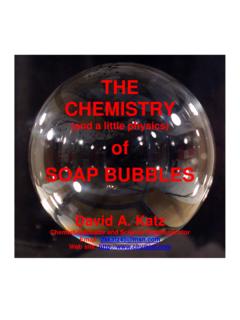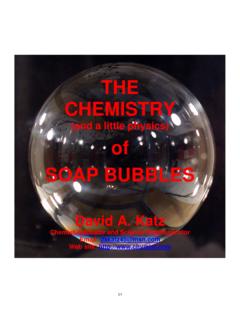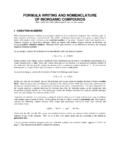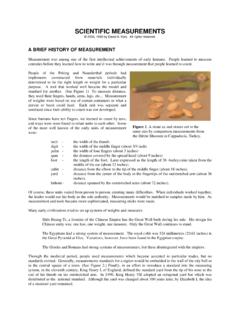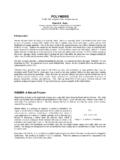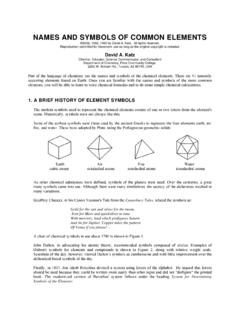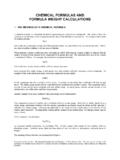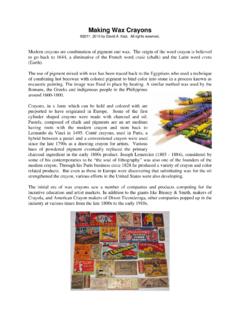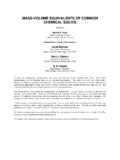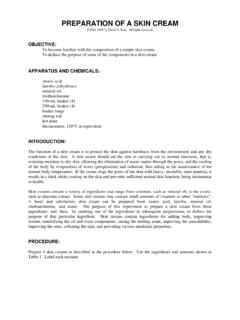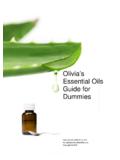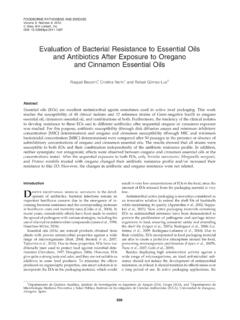Transcription of Isolation of an Essential Oil 2011 - chymist.com
1 Isolation of an Essential Oil 2011, 2010, 2009, 2008 by David A. Katz. All rights reserved. An Essential oil is the essence of a plant which produces its characteristic aroma. Essential oils have been extracted from plants and spices such as allspice, almond, anise, basil, bay, caraway, cinnamon, cumin, dill, eucalyptus, garlic, jasmine, juniper, orange (and other citrus), peppermint, rose, rosemary, sassafras, sandalwood, spearmint, thyme, violet, wintergreen, and more, and valued since ancient times. Extraction processes can be by simple solvent extraction by soaking spices or flowers in water, alcohol, or oil. In this experiment. we will use in the process known as steam distillation to extract the Essential oil. Essential oils consist of a complex mixture of hydrocarbons, alcohols, esters, and carbonyl compounds. Some of these materials are called terpenes. Essential oils , as a group, do not need to have any specific chemical properties in common, beyond conveying characteristic fragrances.
2 Essential oils are used for flavorings, perfumes, and aromatherapy. At different periods in history, eessential oils have been used medicinally. Current medical applications range from skin treatments to remedies for cancer, and are often based on historical use of these oils . Medicinal claims, however, are now subject to regulation in most countries, and, as a result, have grown more vague to stay within these regulations. Use of Essential oils has revived in recent decades with the popularity of aromatherapy, a branch of alternative medicine which claims that the specific aromas carried by Essential oils have curative effects. oils are volatilized or diluted in a carrier oil and used in massage, diffused in the air by a nebulizer or by heating over a candle flame, or burned as incense. Materials Needed Spices, approximately 5 g of one of the following: Cinnamon sticks Whole cloves Cumin seed Fennel seed Allspice, whole Caraway seed Coriander Black pepper Herbs, such as rosemary, peppermint, thyme, lemon verbena, and more Citrus, such as lemon, orange, or grapefruit zests (larger quantities of citrus zest, such as 15 20 g, should be usedfor this procedure) Flowers, such as roses, jasmine, lavender, lily of the valley, violets, carnations, and more (fresh flowers should be used, exact quantities will need to be determined) Jojoba oil (a mixture of wax esters, 36 to 46 carbon atoms long, has a melting point of about 7 C and a boiling point of 398 C) Anhydrous sodium sulfate Distillation apparatus Thermometer, 250 C 25 mL Erlenmeyer flask Test tube, vial, or small bottle (to contain 10-15 mL of product) Procedure Assemble the steam distillation apparatus, as diagrammed below.
3 Use a 150 mL two or three neck round bottom flask and a 50 mL collection flask. (Note: If these size flasks are not available, alternative size flasks will be used.) Apparatus for direct steam distillation Obtain 5 g of a spice, flower, citrus zest, or herb. Break up any large pieces of the spice with a mortar and pestle, but do not grind the spice to a powder. If the spice is particularly hard to grind, it can be crushed by placing it in a plastic bag and crushing it with a heavy weight or hammer. If flowers are used, tear petals into smaller pieces, but do not grind them. Citrus zest should be in small pieces, you can use a zester to shave the zest, but do not grind them as you will remove the oils from the skins. Place the spice, or other material, into the distillation flask and add 50 mL water. Obtain instructor approval before starting the next step. Turn on the water to the condenser, then start heating the liquid in the flask to provide a slow, steady rate of distillation.
4 During the distillation add water from the separatory funnel to maintain the original level of liquid in the distillation flask. Continue the distillation until approximately 25 mL of distillate has been collected in the receiving flask. Disassemble the apparatus, saving the liquid in the receiving flask. Empty the water from the separatory funnel (it is not necessary to dry it) and add the liquid from the receiving flask to it. Extract the Essential oil with jojoba oil by adding 10 mL of jojoba oil to the separatory funnel. Stopper and shake well, venting every few shakes. (Your instructor will demonstrate this.) Allow the layer to separate. The jojoba oil layer will be on top. Drain the water layer into a beaker. Drain the jojoba oil layer into a 25 mL Erlenmeyer flask. If the jojoba oil extract is cloudy, dry the extract with a small amount of anhydrous sodium sulfate. (The sodium sulfate will absorb any water and will clump together.)
5 Decant the clear jojoba oil extract into a clean, test tube or vial. Label the container. This mixture is an Essential oil extract and will be used in the preparation of a perfume.
